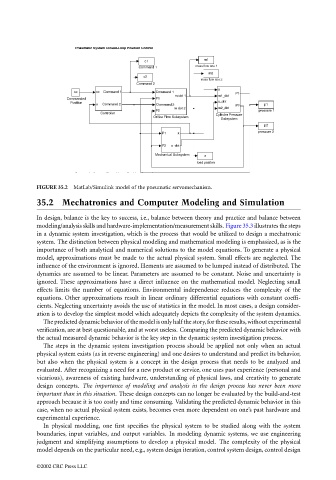Page 1023 - The Mechatronics Handbook
P. 1023
FIGURE 35.2 MatLab/Simulink model of the pneumatic servomechanism.
35.2 Mechatronics and Computer Modeling and Simulation
In design, balance is the key to success, i.e., balance between theory and practice and balance between
modeling/analysis skills and hardware-implementation/measurement skills. Figure 35.3 illustrates the steps
in a dynamic system investigation, which is the process that would be utilized to design a mechatronic
system. The distinction between physical modeling and mathematical modeling is emphasized, as is the
importance of both analytical and numerical solutions to the model equations. To generate a physical
model, approximations must be made to the actual physical system. Small effects are neglected. The
influence of the environment is ignored. Elements are assumed to be lumped instead of distributed. The
dynamics are assumed to be linear. Parameters are assumed to be constant. Noise and uncertainty is
ignored. These approximations have a direct influence on the mathematical model. Neglecting small
effects limits the number of equations. Environmental independence reduces the complexity of the
equations. Other approximations result in linear ordinary differential equations with constant coeffi-
cients. Neglecting uncertainty avoids the use of statistics in the model. In most cases, a design consider-
ation is to develop the simplest model which adequately depicts the complexity of the system dynamics.
The predicted dynamic behavior of the model is only half the story, for these results, without experimental
verification, are at best questionable, and at worst useless. Comparing the predicted dynamic behavior with
the actual measured dynamic behavior is the key step in the dynamic system investigation process.
The steps in the dynamic system investigation process should be applied not only when an actual
physical system exists (as in reverse engineering) and one desires to understand and predict its behavior,
but also when the physical system is a concept in the design process that needs to be analyzed and
evaluated. After recognizing a need for a new product or service, one uses past experience (personal and
vicarious), awareness of existing hardware, understanding of physical laws, and creativity to generate
design concepts. The importance of modeling and analysis in the design process has never been more
important than in this situation. These design concepts can no longer be evaluated by the build-and-test
approach because it is too costly and time consuming. Validating the predicted dynamic behavior in this
case, when no actual physical system exists, becomes even more dependent on one’s past hardware and
experimental experience.
In physical modeling, one first specifies the physical system to be studied along with the system
boundaries, input variables, and output variables. In modeling dynamic systems, we use engineering
judgment and simplifying assumptions to develop a physical model. The complexity of the physical
model depends on the particular need, e.g., system design iteration, control system design, control design
©2002 CRC Press LLC

